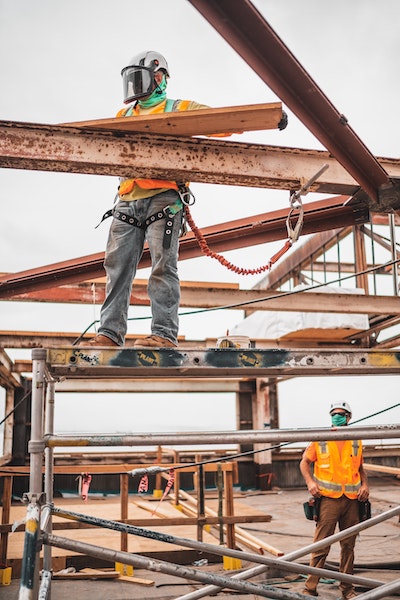Exclusive: What Building Material Distribution Challenges Are Contractors Facing?
A record 93% of contractors are facing at least one material shortage right now.
 While the worst of the COVID-19 pandemic is likely over, the construction industry has not recovered from its impact. Residential construction continues to expand, but commercial construction growth has stalled out as contractors struggle to source goods and labor. Shortages of key materials like lumber and steel are likely slowing the industry’s recovery.
While the worst of the COVID-19 pandemic is likely over, the construction industry has not recovered from its impact. Residential construction continues to expand, but commercial construction growth has stalled out as contractors struggle to source goods and labor. Shortages of key materials like lumber and steel are likely slowing the industry’s recovery.
Distribution challenges that existed before the pandemic have been made worse by supply chain disruptions and a tight labor market. These are the key challenges that contractors face right now, and how industry experts believe the industry might navigate these difficulties.
Record Percentage of Contractors Face Material Difficulties
According to third-quarter data from the U.S. Chamber of Commerce Commercial Construction Index (CCI), a record 93% of contractors are facing at least one material shortage right now.
Additionally, 63% of contractors reported that challenges in sourcing materials are their biggest concerns right now, followed by just 38% concerned about worker safety and 37% concerned about labor shortages.
Difficulties in sourcing materials have been made worse by unusually high material prices.
Lumber Prices Begin to Climb Again After Bottoming Out in August
After recovering to near-pre-pandemic levels in the summer, lumber prices have begun climbing again, likely due to supply cuts, labor shortages, and the recovering residential construction market.
In mid-October, after bottoming out to prices of $389 per thousand board feet in August, lumber prices rose more than 40% to $545. Some experts believe that prices are likely to continue rising, possibly into the $700 range as demand returns and construction starts up again in earnest.
Emerging challenges for growers, like bark beetle infestations in Europe and unfavorable growing conditions, may also lead to long-term price increases and ongoing shortages over the next few years.
Steel Overtakes Lumber as the Material With Most Reported Shortages
Prices for steel are similarly elevated, up 219% since early 2020. These high prices are likely due to a combination of several factors.
For instance, contractors are also reporting difficulties sourcing steel — to the point that, according to CCI data, steel has replaced lumber as the material with the most widely reported shortages. Some contractors are also concerned that tariffs may be making steel and aluminum more difficult to obtain.
When Will Construction Material Shortages End?
Experts aren’t sure when prices may fall or shortages will be resolved. Some industry observers believe that the rise in lumber prices may continue well into 2022. Experts also believe that the steel market may be in a bubble that could burst within the next few months.
All of this is happening amid a historically tight labor market, which has created trouble for almost every industry — from sawmills to steel plants to construction contractors. As significant difficulties exist at almost every link in the supply chain, it’s likely that high prices and material shortages could continue to cause problems well into the future.
Existing Material Distribution Challenges Remain
In addition to shortages and unusually high prices, construction contractors also continue to face material distribution challenges that existed before the pandemic began.
For example, poor land surveying and survey data can still cause significant issues for material procurement and distribution. Imperfect or inaccurate information may easily lead to mistakes regarding the amount and type of materials needed for a project, potentially causing serious delays when these issues become apparent.
Improved land surveying may help contractors manage this problem. Automating land surveying with novel technology like land surveying robots may yield better results and reduce stakeout time. Also, as labor shortages continue, new technology may also help contractors conduct surveys without bringing on additional workers.
On-site material storage is also likely to remain a major challenge. While materials are typically delivered directly to a construction site once ordered, site storage limitations may make this impossible or impractical.
Material orders are also usually staggered over the course of the project, with many contractors only ordering around 80% of the total needed materials at the beginning of the project to avoid overages.
These strategies typically work well but can be easily disrupted by complications like miscommunications, the delivery of materials to the incorrect location, and order errors that result in too-large or too-small quantities.
Contractors can avoid these problems with regular and open communication with suppliers. Construction workers can catch errors in orders and delivery mistakes earlier if they are continuously in touch with their supply vendors.
Optimizing on-site storage usage may also help. Strategies that allow contractors to get the most out of the available storage space can allow them to procure more materials at the same time. Earlier, larger deliveries can provide contractors with more opportunities to order additional materials if an early order is delayed or incorrect.
Working with trusted vendors and business partners with which the contractors have an established relationship may also help. These vendors may be more willing to procure materials on short notice, helping contractors to acquire the last 20% of materials necessary for a project as needed.
How Contractors Are Responding to Material Distribution Challenges
Digitization may help contractors navigate some of these problems. Construction management platforms and software often contain features, for example, that can help businesses predict material usage and optimize on-site material storage.
Digital twins, building management systems (BMSs), and similar digital building planning technologies could provide additional benefits, reducing the uncertainty that can make building materials procurement a challenge.
Increasing off-site construction may also help to simplify material storage and procurement. Because construction companies manufacture prefabricated building components in factories, off-site construction can reduce the amount of material that needs to be distributed to different construction sites for each project.
Contractors Will Continue to Face Building Material Distribution Challenges
The impact of the COVID-19 pandemic is likely to last well into the future. Prices for essential building materials like steel and lumber will remain elevated and shortages will continue. At the same time, contractors will continue to face challenges that existed before the pandemic — like limited on-site storage space.
 New technologies and best practices may help contractors navigate these challenges. For example, BMS platforms and digital twins may help contractors more effectively predict materials usage during construction and predict on-site storage needs. CS
New technologies and best practices may help contractors navigate these challenges. For example, BMS platforms and digital twins may help contractors more effectively predict materials usage during construction and predict on-site storage needs. CS
Emily Newton is an industrial journalist who regularly covers stories in the construction and manufacturing industries. As Editor-in-Chief of Revolutionized, she also covers innovations in the tech and industrial sectors.
















